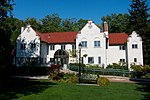Credit River

The Credit River is a river in southern Ontario, which flows from headwaters above the Niagara Escarpment near Orangeville and Caledon East to empty into Lake Ontario at Port Credit, Mississauga. It drains an area of approximately 1,000 square kilometres (390 sq mi). The total length of the river and its tributary streams is over 1,500 kilometres (930 mi). Despite urbanization and associated problems with water quality on the lower section of this river, it provides spawning areas for Chinook salmon and rainbow trout. There is a fish ladder on the river at Streetsville. Much of the river can still be travelled by canoe or kayak. The headwaters of the Credit River is home to a native self-sustaining brook trout population and an introduced brown trout population. Credit Valley Conservation, the local watershed management conservation authority, operates several Conservation Areas including Belfountain, Island Lake, and Terra Cotta. Forks of the Credit Provincial Park is located on the upper part of the river between Brampton and Orangeville, and is near the Bruce Trail. Communities in the river's watershed include the following:
Excerpt from the Wikipedia article Credit River (License: CC BY-SA 3.0, Authors, Images).Credit River
Port Street East, Mississauga Port Credit
Geographical coordinates (GPS) Address Nearby Places Show on map
Geographical coordinates (GPS)
| Latitude | Longitude |
|---|---|
| N 43.547777777778 ° | E -79.580833333333 ° |
Address
Port Credit Harbour Marina
Port Street East
L5G 4V6 Mississauga, Port Credit
Ontario, Canada
Open on Google Maps







